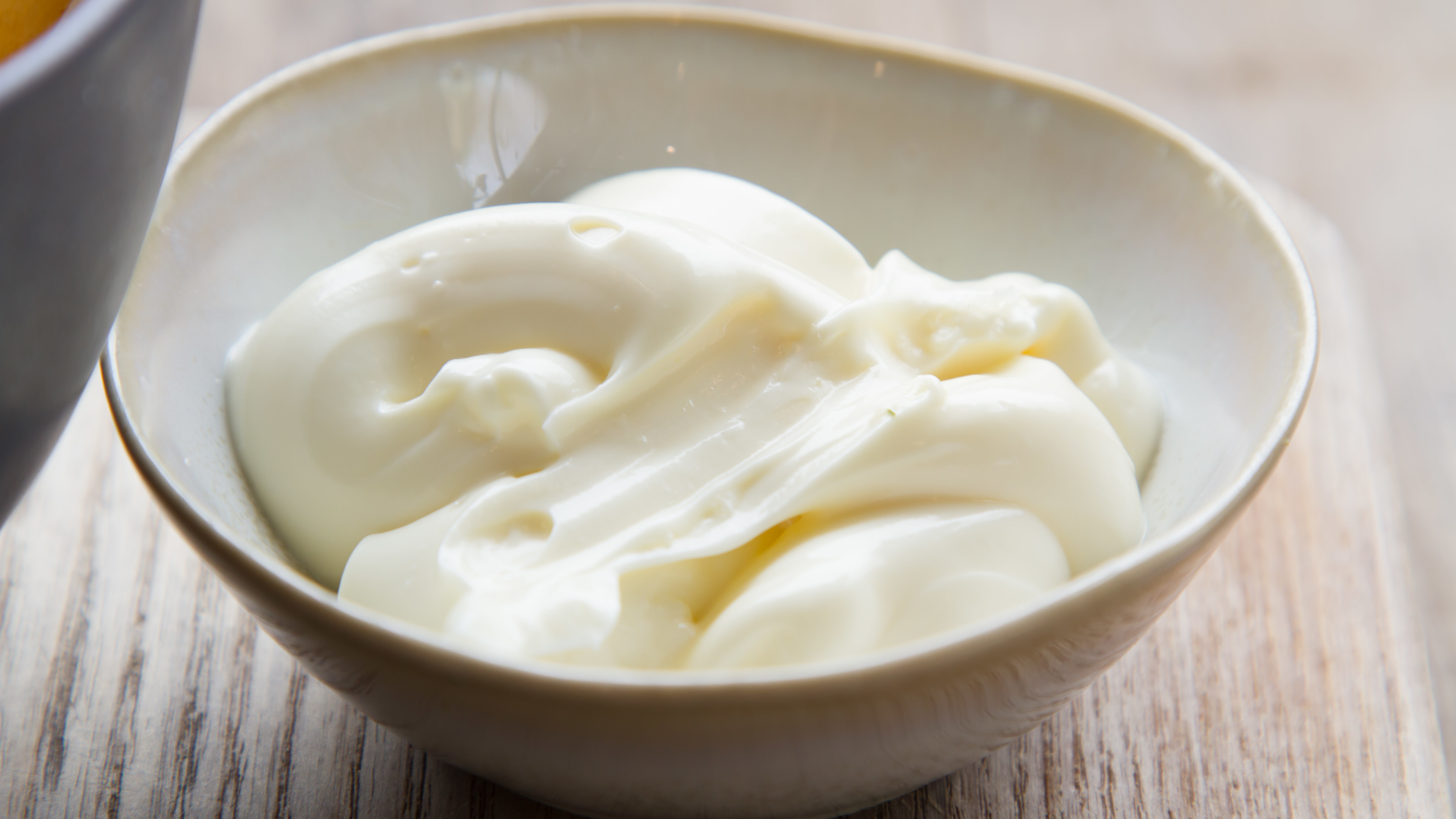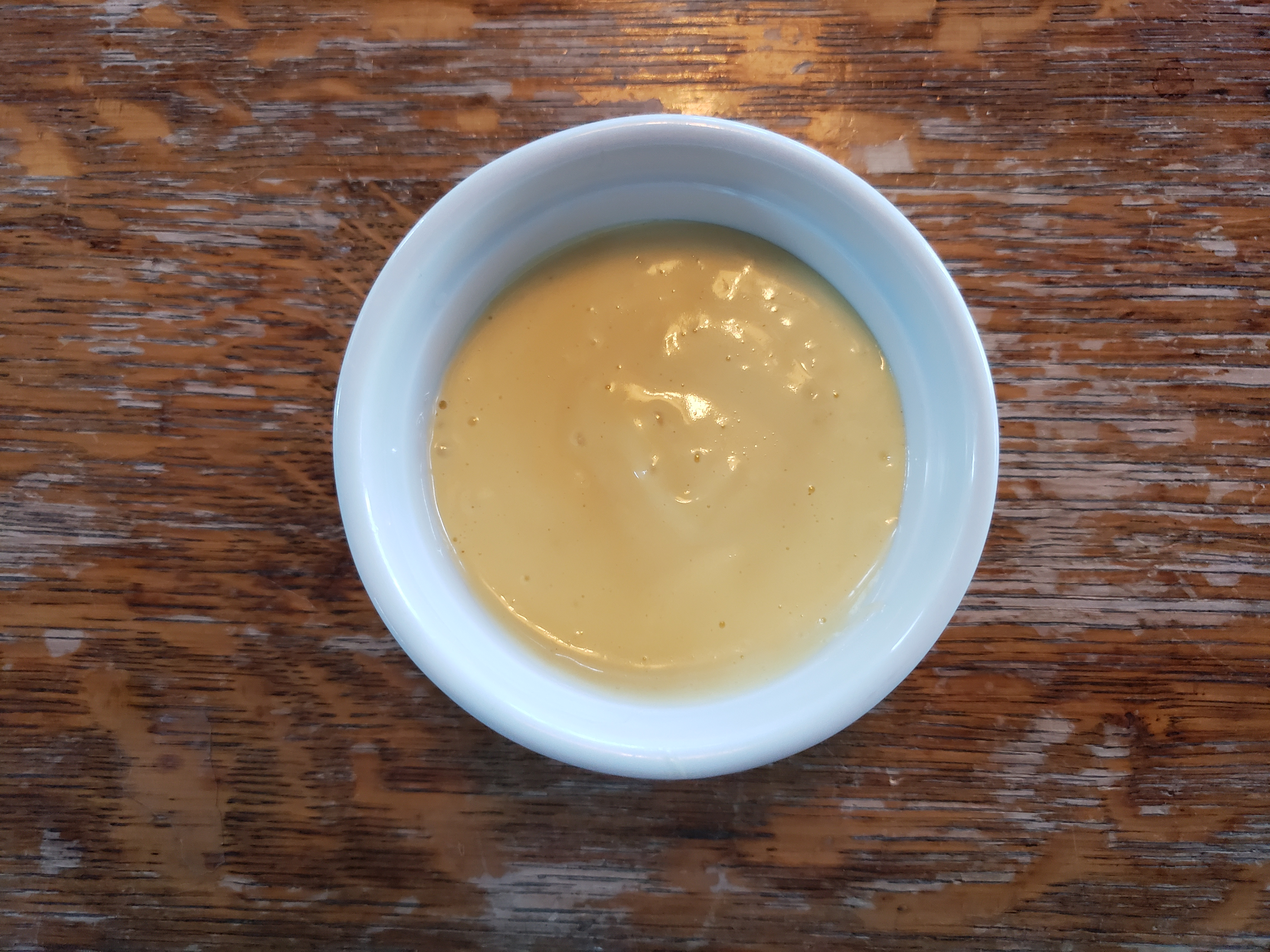Making Homemade Mayo Is Easy—if You Follow The Rules
The creation of mayonnaise has always seemed to me like a mysterious alchemy: eggs and oil combine to create a white, creamy substances that's a sandwich necessity, and a must for some summer salads.
But how hard is it to make from scratch? And is it worth creating your own when Hellmann's and the like fill grocery shelves so generously? I've yet to jump on board the homemade mayo train—but decided to change that this week.
Since mayonnaise is a staple probably since time immemorial, I went to the classics, finding an adorable 1970s Mary Berry video, and grabbing my dog-eared Julia Child volume—Mastering The Art Of French Cooking—to see what they advised.
It seemed pretty simple: a few egg yolks, a little mustard, salt, and an acid like lemon juice or vinegar, then add in oil drop by drop. Chef David Posey of Elske restaurant in Chicago advised, "What type of acid you use can make it totally different. White vinegar is pretty neutral, lemon juice a little fresher, and sherry vinegar is a little more savory."

Still, fairly straightforward, right? Wrong. While my first mayonnaise attempt did at least not curdle, and combined into a substance that seemed mayonnaise-like, it tasted terrible, and came out a canary yellow. My son and I kept tasting it, and kept shuddering. Where had I gone wrong?
Fortunately, chef Adam Biderman of The Company Burger in New Orleans, makes about 12 different types of mayo on the regular, and took a few minutes out of his busy day to become my mayonnaise sensei. There are so many things I did wrong on my first mayonnaise outing. First off, that olive oil. I told him how awful it tasted; he replied: "That's exactly what it's going to do if you just use olive oil. It's too strong and it brings out all the bitterness."
So I asked Biderman what I should do for my second go-around. Since I do not have the wrists of a Julia Child or a Mary Berry, I explained that my method was a electric hand mixer in a large metal bowl. Another mistake. He advised a much smaller bowl. The idea behind emulsions of eggs and oil is that "you want to keep everything as close together as possible, because you're bringing two things together that don't want to be together." To keep things tight, he also advised using an immersion blender over my Mix Master. Perfect mayo methodology even involves your bowl position, ideally tilting the bowl slightly to be able to get the immersion blender submerged into as much of the egg yolk mixture as possible. "When you turn that blender on, it's going to start creating a vortex, and that's where you want to pour your oil," he says. Science! These mini-egg tornadoes hopefully turn into actual mayonnaise. (Of course, a whisk is really all you need, but unfortunately I don't possess John Cena-forearms.)
Jared Wentworth, executive chef at The Dining Room and The Bar at Moody Tongue in Chicago, reminded me to pour the oil in slowly at first. "The most important part of making mayo is creating a tight emulsion. Generally you will whisk all of your ingredients minus your oil together. Then slowly add your oil, first in droplets, then increasing to a stream once an emulsion has been reached. That's it, pretty simple." For him. If your mayo is not coming together, it's going to look like little grains of sand. If that happens, you're better off just starting over than trying to make that failed mayonnaise happen.
Biderman tells me my proportions were nearly correct. The amount of oil an egg needs to properly emulsify is 5 to 6 ounces of oil (he uses soybean salad oil) per yolk. He also suggested canola, but said peanut oil is the ultimate. Just make sure whoever you will be serving this resulting mayonnaise to doesn't have a peanut allergy.
He did say I was missing a small but vital element: "a little bit of water too." The heavy level of friction caused by the emulsion can heat up the eggs or oil to a point where they solidify and can't combine properly, a little ice water can help make my egg yolks a bit more pliable. He said it can also help thin out mayo that's become too tacky to "turn into that ideal, velvety mayonnaise."
Following all this advice (canola oil, smaller bowl that I tried to keep as stationary as possible, a little water), I tried again and... success! I made what could be considered actual mayo. It was creamy and delicious. My son and I have rarely been so surprised by one of my dubious culinary achievements.
Once you have the basic mayo down, the sky's the limit, Wentworth says. "What's pretty great is that there really is no combination of flavored oils that don't follow the general rules of emulsification. I like making a lobster mayo with oil that I have steeped with shells, tomato, and aromatics. If you have ever infused herb oils, try them out for your mayo. Basil oil mayonnaise on heirloom tomatoes is great. Tarragon mayonnaise with grilled fish is another one that's an easy go-to sauce." Thanks god we're at the start of summer so I can try all these out proper.
You could also use roasted garlic. Or bacon crumbles. "We've done things as crazy as mixing cheddar cheese and green onions in with our mayonnaise and serving it with tater tots," Biderman says. Clearly, in the mayo world, anything goes.
But, baby steps and all that. To start off, here's a recipe from Wentworth for basic mayo that could be flavored with almost anything you like. Except, for god's sake, stay away from olive oil.
Homemade Mayonnaise
- 2 egg yolks
- 1 cup vegetable oil
- 1 tsp. lemon juice
- 1 tsp. Dijon mustard
- 1 tsp. white wine vinegar
- Salt to taste
Add all ingredients to mixing bowl minus the oil.
Slowly whisk in droplets of oil, increase the speed of adding oil as your emulsion is bound. If too thick, thin out with a drop or two of water. Season to taste with salt.

